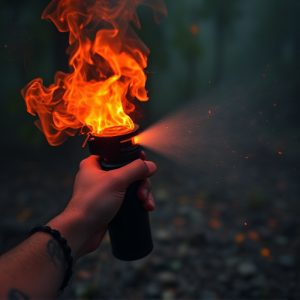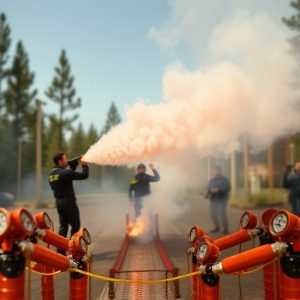Law Enforcement Guide to Wildfire Pepper Spray for Effective and Legal Fire Management
Wildfire pepper spray is an essential non-lethal tool for law enforcement, providing effective crow…….
Wildfire pepper spray is an essential non-lethal tool for law enforcement, providing effective crowd and confrontation management by incapacitating individuals with a high concentration of oleoresin capsicin. The effects last approximately 30 to 45 minutes and can be deployed up to 20 feet away, reducing the risk of direct engagement. To use it effectively, officers require comprehensive training on its application, effects, and limitations, including recognizing exposure signs and understanding post-exposure care. Proper integration of this tool into operational protocols necessitates a deep understanding of its capabilities and implications for safety and efficacy in various scenarios. The spray's non-lethal nature makes it crucial in managing civil unrest or public demonstrations, ensuring that only those who pose a threat are targeted, in compliance with international standards for non-lethal chemical use, human rights, and public safety. Law enforcement must consider legal, ethical, and environmental factors when deploying the spray, adhering to jurisdiction-specific regulations and maintaining transparency to foster public trust and accountability. Regular assessment and ethical review are critical to confirm its appropriate use, balancing the need for order with the protection of individual rights.
Wildfire pepper spray emerges as a critical tool for law enforcement in managing and suppressing wildfires, enhancing public safety during these hazardous events. This article delves into the practical applications of this specialized agent, guiding officers through its science, deployment strategies, and legal use considerations. From understanding its mechanics to navigating ethical boundaries, our comprehensive guide ensures that law enforcement is well-equipped to employ wildfire pepper spray effectively and responsibly in the face of fiery threats.
Understanding Wildfire Pepper Spray: A Comprehensive Guide for Law Enforcement
Wildfire pepper spray stands as a critical tool for law enforcement agencies, offering an effective non-lethal means to control and manage crowd situations or confrontations where traditional policing methods may be insufficient or pose excessive risk. This specialized form of pepper spray is designed with a high concentration of oleoresin capsicum (OC), delivering a powerful and temporary incapacitating agent that can deterrit individuals, provide time for law enforcement to take control of the situation, and safeguard both the public and officers themselves. Its potency is such that it can be delivered up to 20 feet away, allowing for a safe distance between the subject and the officer during deployment. Understanding its application, effects, and limitations is paramount for law enforcement personnel to effectively integrate this tool into their operational protocols.
In terms of effectiveness, wildfire pepper spray is engineered to be more robust than conventional pepper sprays. It incapacitates by causing intense irritation to the eyes, skin, and respiratory tract upon contact. The effects can last from 30 to 45 minutes, providing a substantial window for law enforcement to neutralize a threat or apprehend an individual. Training with this specific type of pepper spray is essential to ensure that officers understand its impact, know how to deploy it accurately and safely, and can recognize the signs of its effects in subjects and themselves. Additionally, understanding the legal implications, environmental considerations, and the proper procedures for post-exposure care are all facets of its use that law enforcement must be thoroughly trained in to effectively employ wildfire pepper spray in various scenarios.
The Science Behind Wildfire Pepper Spray: Effectiveness and Safety Considerations
Wildfire pepper spray is a specialized formulation designed for law enforcement to effectively manage and control crowd dynamics during scenarios such as civil unrest, public demonstrations, or other situations where crowd control measures are necessary. The active ingredient in this spray, capsaicin, derived from chili peppers, induces an intense irritation upon contact with the eyes, skin, and respiratory tract of individuals affected by it. This incapacitating effect temporarily impairs an individual’s ability to see, breathe, and react, allowing for the safe management of a situation without causing permanent harm.
The effectiveness of wildfire pepper spray lies in its potency and the speed at which it can neutralize a threat. Upon deployment, the spray creates a dense, irritant-laden cloud that can disperse or subdue individuals up to a certain range. It is formulated to minimize the risk of drifting back towards the officers deploying it, thus enhancing safety for both law enforcement personnel and those within the vicinity who are not targets of the spray. Safety considerations are paramount in the development and deployment of this product; it undergoes rigorous testing to ensure that it is only effective against individuals posing a threat but also that its use complies with international standards for chemical non-lethality, human rights, and public safety. Training is essential for law enforcement officers to understand the proper application techniques and to be aware of the environmental conditions that can affect the dispersion pattern of the spray. This ensures that wildfire pepper spray remains a valuable tool in maintaining public order while minimizing potential harm.
Deploying Wildfire Pepper Spray in Wildfire Situations: Strategies and Best Practices for Law Enforcement
Law enforcement agencies must be adequately equipped and trained to handle the unique challenges posed by wildfires, particularly when it comes to protecting lives and property. Wildfire pepper spray is an invaluable tool in these scenarios, as it allows officers to safely disperse crowds or deter individuals from entering high-risk areas without the need for lethal force. When deploying this specialized pepper spray, which is formulated to be more effective against large groups of people in open spaces, it is crucial to consider wind direction and the layout of the area to minimize the risk of the irritant drifting back towards officers or into unintended areas. Best practices dictate that law enforcement should use these sprays as part of a coordinated response with other emergency services, ensuring that communication channels remain open and that all personnel are aware of each other’s positions and actions. Training exercises should simulate real-world conditions to familiarize officers with the product’s range, effectiveness, and potential environmental impact, thereby enhancing their ability to respond effectively to wildfire situations.
Incident commanders must strategically plan the use of wildfire pepper spray, taking into account factors such as visibility, weather conditions, and the movement of the population affected by the fire. It is also essential to have a clear protocol for decontamination and medical assistance immediately available for those who may come into contact with the spray. By adhering to these strategies and best practices, law enforcement can effectively use wildfire pepper spray as a non-lethal means of protection and crowd control during these high-stress, high-risk events, ultimately contributing to a more coordinated and safe response effort.
Legal Implications and Ethical Use of Wildfire Pepper Spray by Law Enforcement Agencies
Law enforcement agencies are increasingly turning to advanced non-lethal munitions like Wildfire pepper spray for crowd and riot control due to its potent and immediate incapacitating effects. The legal implications of deploying such a tool are multifaceted, requiring careful consideration of applicable laws and regulations. Legislation governing the use of chemical irritants varies by jurisdiction, with some regions having stringent restrictions on their use, while others offer broader latitude for law enforcement discretion. It is imperative that agencies operating Wildfire pepper spray are fully aware of the legal frameworks within which they must act. The use of this spray must be justified and proportionate to the threat faced, with clear protocols established to prevent misuse or unnecessary harm to individuals.
Ethical considerations also play a critical role in the deployment of Wildfire pepper spray. Ethics dictates that any non-lethal force employed by law enforcement should balance public safety with the protection of individual rights. The ethical use of this spray necessitates training and oversight to ensure that officers understand the effects, durability, and appropriate contexts for its use. Transparency in reporting incidents involving Wildfire pepper spray is essential to maintain public trust and accountability. Moreover, ongoing assessment and review of its applications are crucial to ensure that ethical standards are consistently upheld and that the tool is used as intended—to maintain order without causing undue harm or suffering.


